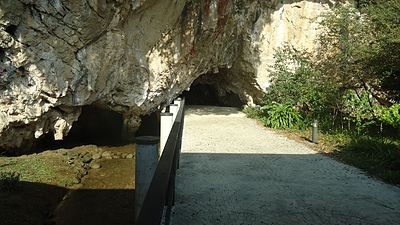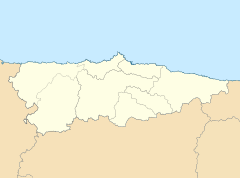
In archaeology, cave paintings are a type of parietal art, found on the wall or ceilings of caves. The term usually implies prehistoric origin. These paintings were often created by Homo sapiens, but also Denisovans and Neanderthals; other species in the same Homo genus. Discussion around prehistoric art is important in understanding the history of the Homo sapiens species and how Homo sapiens have come to have unique abstract thoughts. Some point to these prehistoric paintings as possible examples of creativity, spirituality, and sentimental thinking in prehistoric humans.

Creswell Crags is an enclosed limestone gorge on the border between Derbyshire and Nottinghamshire, England, near the villages of Creswell and Whitwell. The cliffs in the ravine contain several caves that were occupied during the last ice age, between around 43,000 and 10,000 years ago. Its caves contain the northernmost cave art in Europe. The evidence of occupation found in the rich series of sediments that accumulated over many thousands of years is regarded as internationally unique in demonstrating how prehistoric people managed to live at the extreme northernmost limits of their territory during the Late Pleistocene period.

In the history of art, prehistoric art is all art produced in preliterate, prehistorical cultures beginning somewhere in very late geological history, and generally continuing until that culture either develops writing or other methods of record-keeping, or makes significant contact with another culture that has, and that makes some record of major historical events. At this point ancient art begins, for the older literate cultures. The end-date for what is covered by the term thus varies greatly between different parts of the world.

The Cave of Altamira is a cave complex, located near the historic town of Santillana del Mar in Cantabria, Spain. It is renowned for prehistoric cave art featuring charcoal drawings and polychrome paintings of contemporary local fauna and human hands. The earliest paintings were applied during the Upper Paleolithic, around 36,000 years ago. The site was discovered in 1868 by Modesto Cubillas and subsequently studied by Marcelino Sanz de Sautuola.

Magdalenian cultures are later cultures of the Upper Paleolithic and Mesolithic in western Europe. They date from around 17,000 to 12,000 years ago. It is named after the type site of La Madeleine, a rock shelter located in the Vézère valley, commune of Tursac, in France's Dordogne department.

The Upper Paleolithic is the third and last subdivision of the Paleolithic or Old Stone Age. Very broadly, it dates to between 50,000 and 12,000 years ago, according to some theories coinciding with the appearance of behavioral modernity in early modern humans, until the advent of the Neolithic Revolution and agriculture.
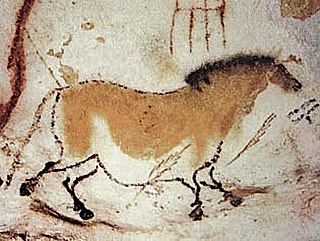
The Franco-Cantabrian region is a term applied in archaeology and history to refer to an area that stretches from Asturias, in northern Spain, to Aquitaine and Provence in Southern France. It includes the southern half of France and the northern strip of Spain looking at the Bay of Biscay.

Ribadesella is a small 84-square-kilometre (32 sq mi) municipality in the Autonomous Community of the Principality of Asturias, Spain. Known for its location on the Cantabrian Sea, at the outlet of the River Sella, Ribadesella is a town that forms part of the Picos de Europa. It is bordered on the east by Llanes, on the south by Cangas de Onís and Parres, and on the west by Caravia. Ribadesella is the home town of Queen Letizia of Spain.

Prehistoric France is the period in the human occupation of the geographical area covered by present-day France which extended through prehistory and ended in the Iron Age with the Roman conquest, when the territory enters the domain of written history.

Cueva de La Pasiega, or Cave of La Pasiega, situated in the Spanish municipality of Puente Viesgo, is one of the most important monuments of Paleolithic art in Cantabria. It is included in the UNESCO World Heritage List since July 2008, as part of the inscription: Cave of Altamira and Paleolithic Cave Art of Northern Spain.

The art of the Upper Paleolithic represents the oldest form of prehistoric art. Figurative art is present in Europe and Southeast Asia, beginning around 50,000 years ago. Non-figurative cave paintings, consisting of hand stencils and simple geometric shapes, are somewhat older, at least 40,000 years old, and possibly as old as 64,000 years. This latter estimate is due to a controversial 2018 study based on uranium-thorium dating, which would imply Neanderthal authorship and qualify as art of the Middle Paleolithic.
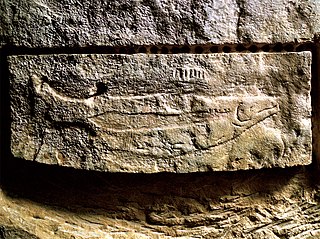
The Prehistoric Sites and Decorated Caves of the Vézère Valley is a UNESCO World Heritage Site in France since 1979. It specifically lists 15 prehistoric sites in the Vézère valley in the Dordogne department, mostly in and around Les Eyzies-de-Tayac-Sireuil, which has been called the "Capital of Prehistory". This valley is exceptionally rich in prehistoric sites, with more than 150 known sites including 25 decorated caves, and has played an essential role in the study of the Paleolithic era and its art. Three of the sites are the namesakes for prehistoric periods; the Micoquien, Mousterian, and Magdalenian. Furthermore, the Cro-Magnon rock shelter gave its name to the Cro-Magnon, the generic name for the European early modern humans. Many of the sites were discovered or first recognised as significant and scientifically explored by the archaeologists Henri Breuil and Denis Peyrony in the early twentieth century, while Lascaux, which has the most exceptional rock art of these, was discovered in 1940.

Cro-Magnons or European early modern humans (EEMH) were the first early modern humans to settle in Europe, migrating from western Asia, continuously occupying the continent possibly from as early as 56,800 years ago. They interacted and interbred with the indigenous Neanderthals of Europe and Western Asia, who went extinct 40,000 to 35,000 years ago. The first wave of modern humans in Europe left no genetic legacy to modern Europeans; however, from 37,000 years ago a second wave succeeded in forming a single founder population, from which all subsequent Cro-Magnons descended and which contributes ancestry to present-day Europeans. Cro-Magnons produced Upper Palaeolithic cultures, the first major one being the Aurignacian, which was succeeded by the Gravettian by 30,000 years ago. The Gravettian split into the Epi-Gravettian in the east and Solutrean in the west, due to major climatic degradation during the Last Glacial Maximum (LGM), peaking 21,000 years ago. As Europe warmed, the Solutrean evolved into the Magdalenian by 20,000 years ago, and these peoples recolonised Europe. The Magdalenian and Epi-Gravettian gave way to Mesolithic cultures as big game animals were dying out and the Last Glacial Period drew to a close.

The Cantabrian caves' unique location make them an ideal place to observe the settlements of early humans thousands of years ago. The magnificent art in the caves includes figures of various animals of the time such as bison, horses, goats, deer, cattle, hands and other paintings. Archaeologists have found remains of animals such as bears, the remains of arrows and other material indicating a human presence; these artifacts are now found mostly in the Regional Museum of Prehistory and Archaeology of Cantabria.

The Neanderthals in Gibraltar were among the first to be discovered by modern scientists and have been among the most well studied of their species according to a number of extinction studies which emphasize regional differences, usually claiming the Iberian Peninsula partially acted as a “refuge” for the shrinking Neanderthal populations and the Gibraltar population of Neanderthals as having been one of many dwindling populations of archaic human populations, existing just until around 42,000 years ago. Many other Neanderthal populations went extinct around the same time.

Armintxe Cave in Lekeitio (Spain) is an important Paleolithic rock art site, estimated to date from between 12,000 and 14,500 years ago.

The small Sirgenstein Cave, German: Sirgensteinhöhle is situated 565 m (1,854 ft) above sea level inside the 20 m (66 ft) high Sirgenstein, a limestone rock. The cave sits 35 m (115 ft) above the Ach River valley bottom in the central Swabian Jura, southern Germany. Archaeologist R. R. Schmidt excavated the site in 1906 during which he identified indices of prehistoric human presence. He recorded the complete stratigraphic sequence of Palaeolithic and Neolithic origin. In his 1910 analysis Schmidt inspired future archaeologists with his pioneering concept of including the excavation site within its geographic region, contextualizing it within a wide scientific spectrum and demonstrated valuable results as he correlated the Sirgenstein layer structure to those of prehistoric sites in France. Mammoth ivory beads dating from 39,000 to 35,000 years ago have been uncovered at the cave. Because of its historical and cultural significance and its testimony to the development of Paleolithic art, the cave was inscribed on the UNESCO World Heritage List as part of the Caves and Ice Age Art in the Swabian Jura site in 2017.
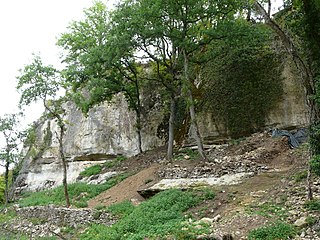
Castel Merle is a complex of 10 prehistoric rock shelters in Sergeac, in the Dordogne region of France. It is close to the Lascaux rock art caves and is situated in the region which forms the Unesco World Heritage site Prehistoric Sites and Decorated Caves of the Vézère Valley, but is not officially a part of it. The finds in the shelters date to the Mousterian and Magdalenian periods, or between 160,000 and 12,000 years ago. The most important of the 10 shelters is the Reverdit rockshelter.

The Paleolithic in the Iberian peninsula is the longest period of Iberian prehistory, spanning from c. 1.3 million years ago (Ma) to c. 11,500 years ago, ending at roughly the same time as the Pleistocene epoch. The Paleolithic was characterized by climate oscillations between ice ages and small interglacials, producing heavy changes in Iberia's orography. Cultural change within the period is usually described in terms of lithic industry evolution.

